Acids are substances that taste sour and are corrosive in nature. It turns blue litmus paper to red. These substances are chemically acidic in nature.E.g.:-orange juice, curd, vinegar, hydrochloric acid etc.
Bases are substances that, in an aqueous solution, are slippery to the touch and bitter in taste. It turns red litmus paper to blue. These substances are chemically basic in nature. Eg:- soap, ammonium hydroxide, calcium hydroxide, etc.
Salt is an ionic compound that results from the neutralization reaction of acids and bases. Salts are constituted of positively charged ions, known as cations, and negatively charged ions, known as anions, which can either be organic or inorganic in nature. These ions are present in a relative amount, thus rendering the nature of the salt neutral.
Download PDF of Class 10 Chemistry Worksheet Chapter 2 Acids, Bases and Salts – Set 1
CBSE Class 10 Chemistry Worksheet Chapter 2 Acids, Bases and Salts – Set 1
Q1. The property which is not shown by acids is-
a.) they have a sour taste.
b.) they feel soapy.
c.) they turn litmus red.
d.) their pH is less than 7.
Q2. A solution reacts with zinc granules to give a gas which burns with a pop sound. The solution contains:
a.) Mg(OH)2
b.) Na2CO3
c.) NaCl
d.) HCl
Q3. A solution turns red litmus blue. Its pH is likely to be:
a.) 1
b.) 4
c.) 5
d.) 10
Q4. Which of the following salts does not contain water of crystallisation?
a.) Blue vitriol
b.) Baking soda
c.) Washing soda
d.) Gypsum
Q5. Bases generate ___ ions in water.
a.) H–
b.) H+
c.) OH–
d.) OH+
Q6. What is the role of tartaric acid in baking powder?
Q7. What is the chemical formula of blue vitriol?
Q8. What is the role of HCl present in the stomach?
Q9. What is the effect of dilution on an acid or base?
Q10. Explain why bases are not kept in metal containers?
Q11. State the chemical property in each case on which the following uses of baking soda are based:
i.) As an antacid
ii.) As a constituent of baking powder.
Q12. What is the water of crystallisation?
Q13. Define olfactory indicators.
Q14. While diluting an acid why is it recommended that the acid should be added to water and not water to the acid?
Q15. Sea water contains many salts dissolved in it. How can the salt that we use in the food is obtained?
Q16.
a.) What happens when zinc granules are heated with sodium hydroxide solution?
b.) What does pH stand for? What does it indicate?
Q17. a.) What is gypsum? What happens when gypsum is heated at 100℃?
b.) What is the common name of the compound CaOCl2?
c.) Explain why chlorine is used for sterilising the drinking water supply?
Q18. a.) What is baking powder? How does it make the cake soft and spongy?
b.) In addition to sodium hydrogen carbonate, baking powder contains a substance X. Name the substance X. What is the role of substance X in the baking powder?
c.) State the two uses of sodium hydroxide.
Q19. a.) A knife, which is used to cut fruit, was immediately dipped into water containing drops of blue litmus solution. If the colour of the solution is changed to red, what inference can be drawn about the nature of the fruit and why?
b.) What should be done if someone accidentally touches the leaves of a nettle plant in the wild?
c.) Two solutions X and Y have pH = 4 and pH = 8, respectively. Which solution will give an alkaline reaction and which one acidic?
Q20. Answer the following-
a.) Compounds such as alcohol and glucose also contain hydrogen but are not categorised as acids. Why?
b.) Why do acids not show acidic behaviour in the absence of water?
c.) Why should curd and other sour foodstuffs not be kept in the metal container?
d.) Name three common indicators.
Download PDF to access answers of the Chemistry Worksheet for Class 10 Chemistry Chapter 2: Acids, Bases and Salts Set – 1
Download PDF
Read Also:
- Acids, Bases, and Salts
- Properties of Acids and Bases
- Acids and Bases Questions
- Class 10 Chemistry Chapter 2 – Acids, Bases and Salts Important Questions with Answers
- Class 10 Chemistry Chapter 2 Acids, Bases and Salts MCQs
Recommended Videos
Properties of Acids and Bases Class 10




